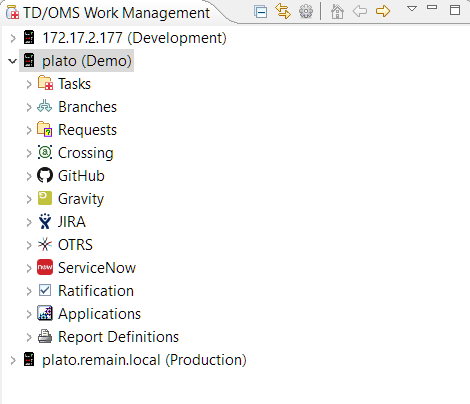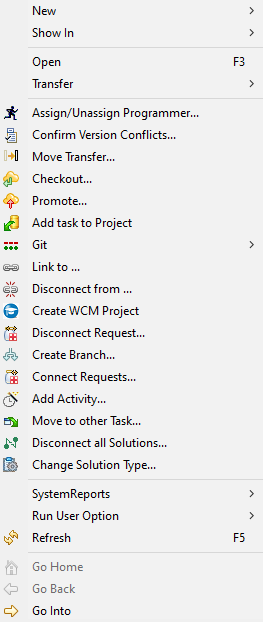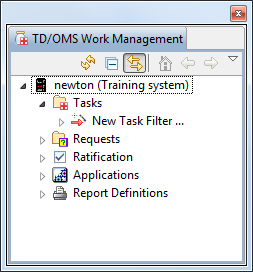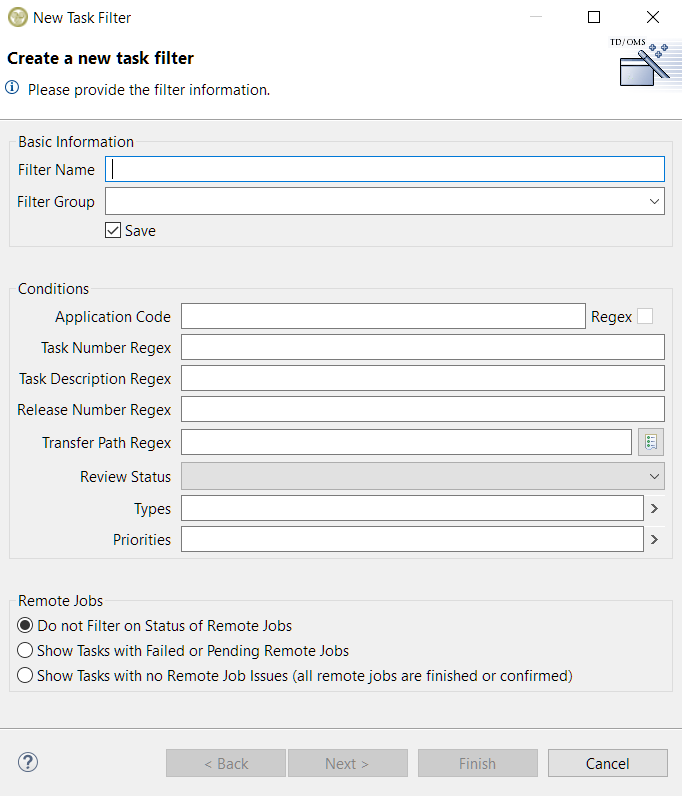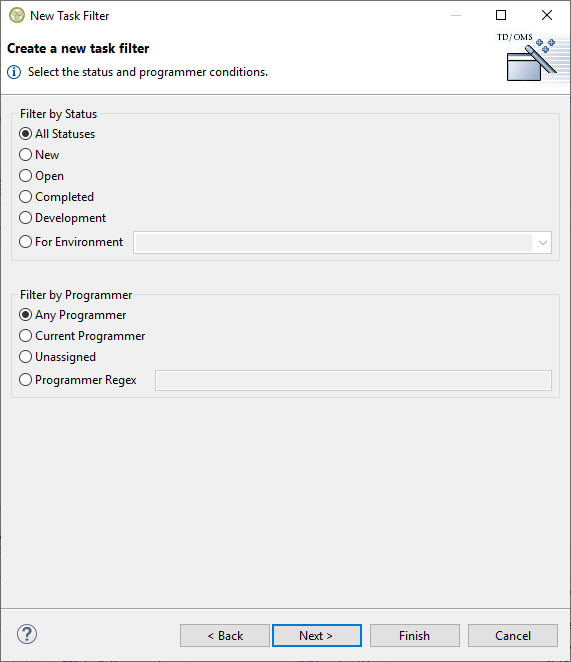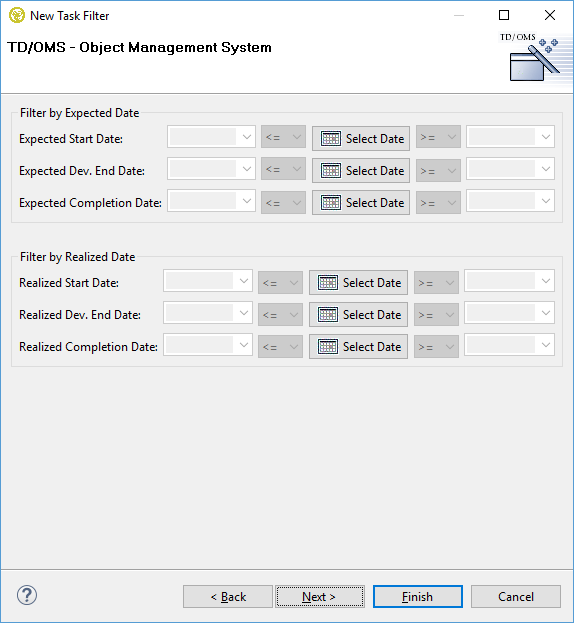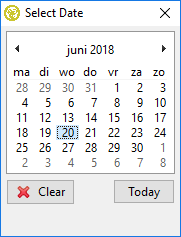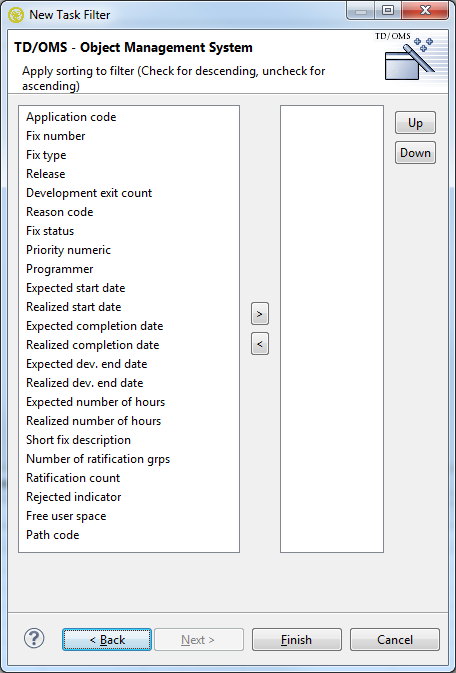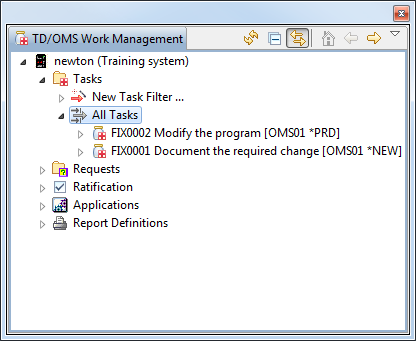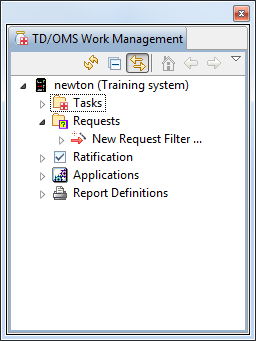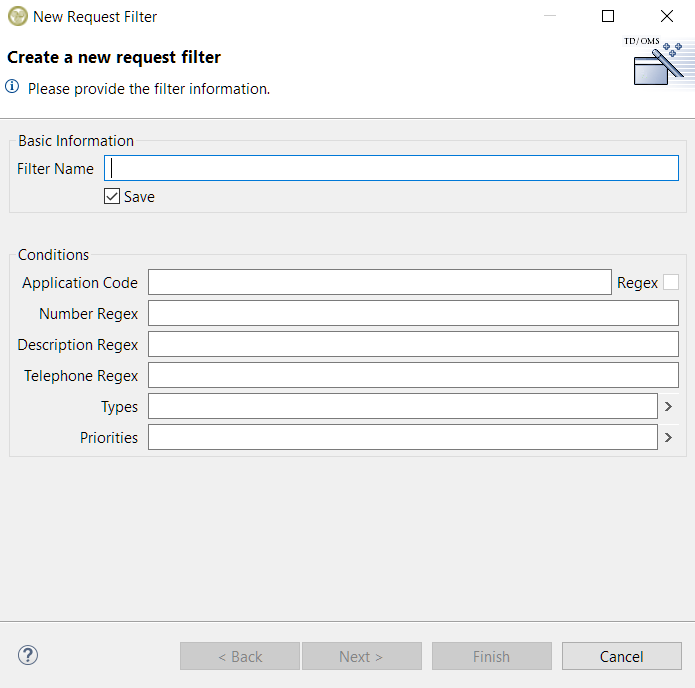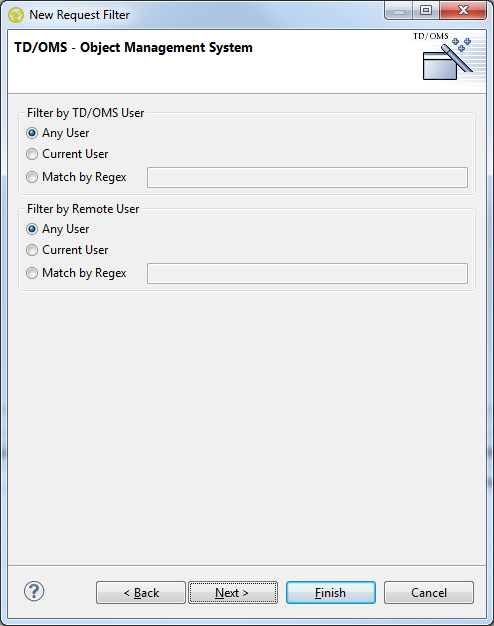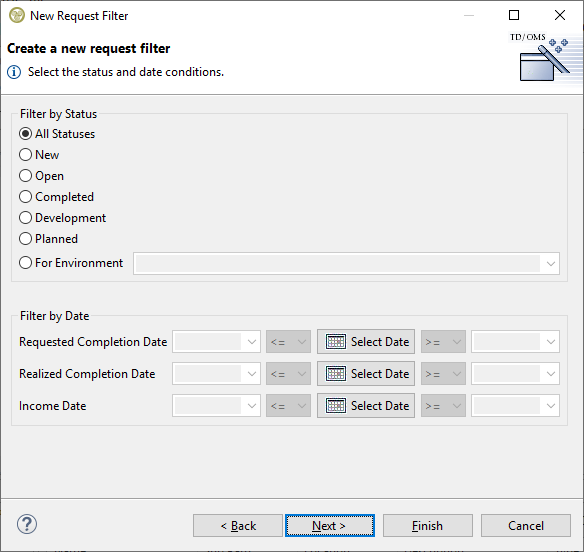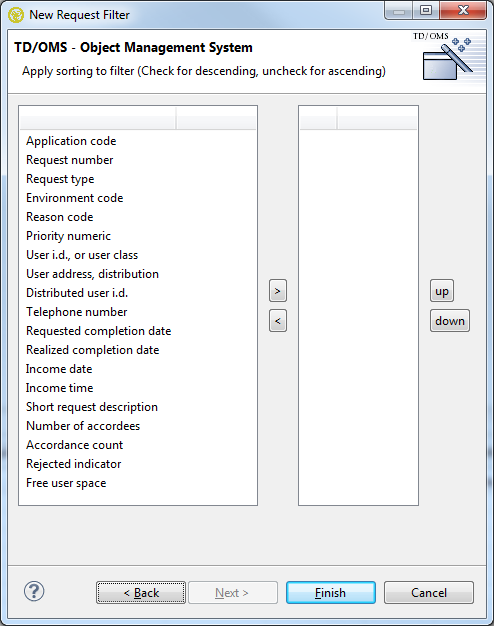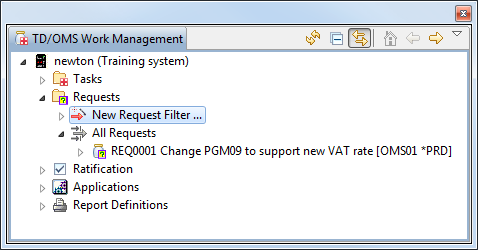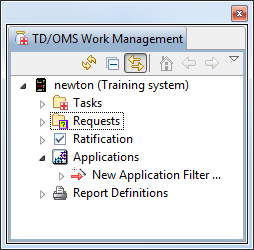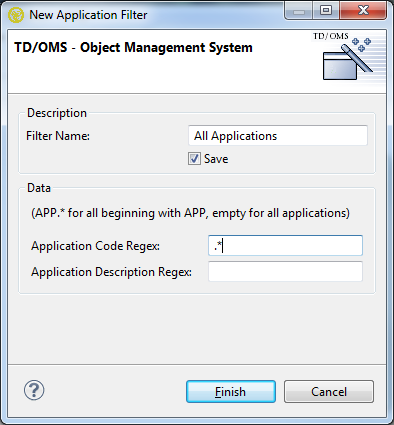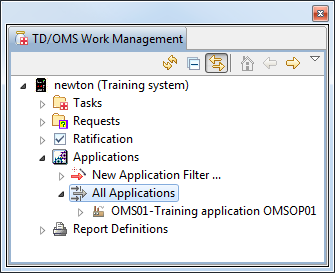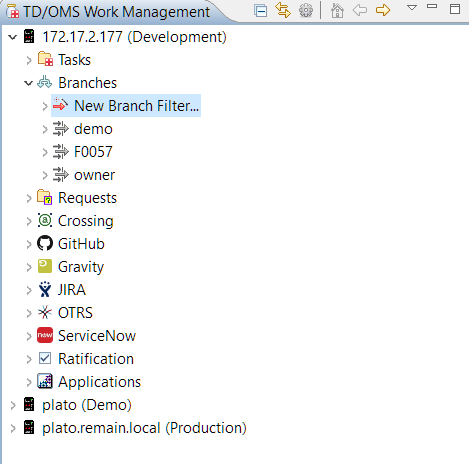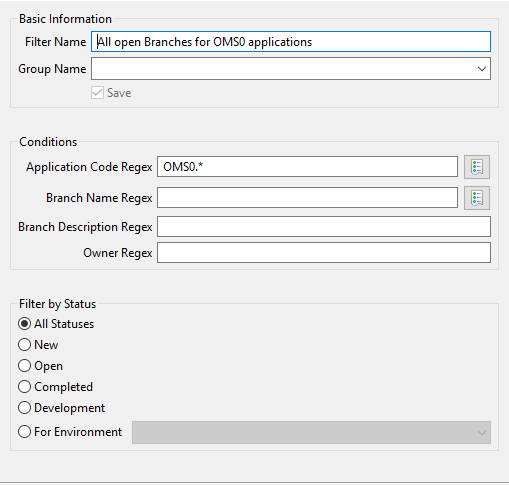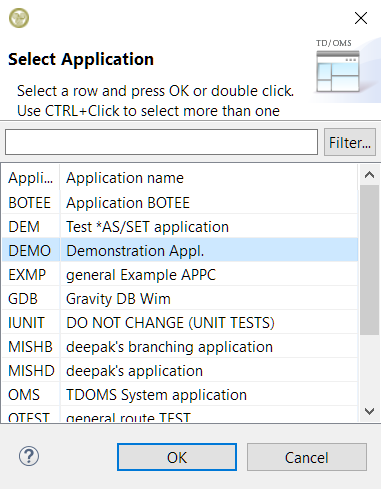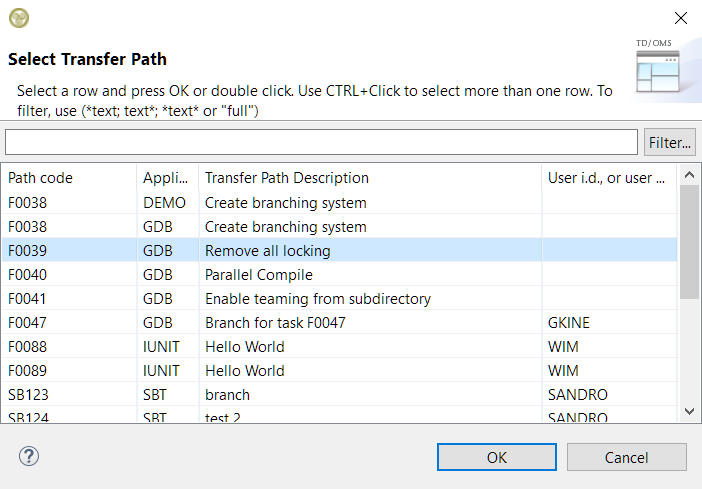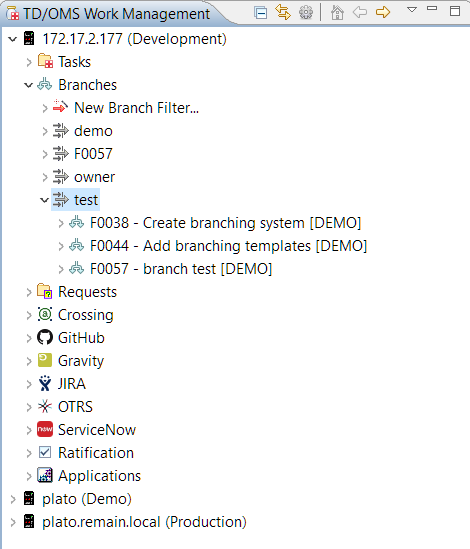Translations:EWM:Using the views/5/en
TD/OMS Work Management view
All defined hosts will appear in the Work Management view. When you expand the system node, additional nodes will appear below it. The number of nodes will vary depending on the number of installed TD/OMS-modules and plug-ins. The nodes represent the main entities of the work management view.
The most important nodes are:
- Tasks
- Shows lists of tasks, each one defined by a filter. Every list may contain tasks of different applications.
- Branches
- Shows lists of branches, each one defined by a filter. A list may contain branches from different applications.
- Requests
- Shows lists of requests, each one defined by a filter. A list may contain requests from different applications.
- Applications
- Shows lists of applications, each one defined by a filter.
- Ratification
- Shows a list of the ratification groups of which you are a member for all application/environment combinations defined.
- Report Definitions
- Shows the canned and user-defined reports that are currently defined. It enables you to create, run and modify reports.
Decorations
Sometimes, the icons and texts are decorated. This is visible by a change in text style or by an overlay on the icon. The following decorations are used:
Icon Decorations
 - Compilation failed
- Compilation failed - Potential version conflict (plus blue underlined text)
- Potential version conflict (plus blue underlined text) - Version conflict (plus red double underlined text)
- Version conflict (plus red double underlined text) - Item is in development, you may edit it.
- Item is in development, you may edit it. - This object is in the Terminate state.
- This object is in the Terminate state. - Item is locked. It cannot be transferred.
- Item is locked. It cannot be transferred. - Item is being deployed.
- Item is being deployed. - Deployment has failed. Check the logs.
- Deployment has failed. Check the logs. - Blue Dot. The item has labels.
- Blue Dot. The item has labels. - Pink Dot. The item has compile overrides.
- Pink Dot. The item has compile overrides. - Information icon. The item has comments.
- Information icon. The item has comments.
Text Decorations
 - Assigned to you (bold description)
- Assigned to you (bold description) - This item is complete (strikethrough)
- This item is complete (strikethrough) - Potential version conflict (plus blue top-left arrow in icon)
- Potential version conflict (plus blue top-left arrow in icon) - Version conflict (plus red top-left arrow in icon)
- Version conflict (plus red top-left arrow in icon) - This item is attached to (2) tasks.
- This item is attached to (2) tasks. - This item is attached to (1) local task but also to tasks in related applications (+).
- This item is attached to (1) local task but also to tasks in related applications (+).
Context Menu Actions
The actions you see in the context menu will vary depending on the context and the number of plugins that you installed.
If the action that you are looking for is not in this list, try searching for it in the search box at the top of the screen.
The common context menu actions are:
- New > Create new items like Tasks and Objects.
- Show In > The Show In menu tells you where there is more information about the selected item.
- Open
- Assign/Unassign programmer...
- Confirm Version Conflicts...
- Move Transfer...
- Checkout...
- Promote...
- Add Task to Project...
- Git...
- Link to...
- Disconnect from...
- Connect Task to Request
- Connect Request to Task
- Disconnect Task
- Complete Task and Complete Request
- Disconnect Solution
- Change Solution Type
- Move Solutions
Create a Task Filter
The first node in the Work Management view shows lists of tasks, each one defined by a filter. Every list may contain tasks of different applications. Before you can see tasks you must create a Filter. When a Filter is expanded, it shows the Tasks included in that Filter which could be in turn included in a Filter Group.
Expand the node called Tasks.
Double-clicking New Task Filter… starts a dialog for specifying the selection criteria. A task must pass ALL criteria to be selected.
If Save is not checked, the filter will be deleted when the client is closed !
- Filter Name
- Define the name of the filter. This is also the name the filter is saved with so some restrictions apply.
- Filter Group
- When specified, a filter group is created that contains the filter. It is convenient to group filters if you have a large number of filters.
- Save
- If you uncheck this then the filter will become a session filter which will be removed after restart.
- Application Code
- Specify an application code or a Regular Expression like DEM.* or (ORDER|TOOLS).
- Regex
- Will cause the tasks to be selected in the client rather than in the database request. It is therefor slower but more flexible.
- Task Number Regex
- Type a regular expression to find the task number like F0122 or F01.*
- Task Description Regex
- Type a regular expression to find the task description like .*decimal.*
- Release Number Regex
- Key a regular expression to find the task release like V3R0M0 or V3.*
- Transfer Path Regex
- Key a regular expression to find the task with the request Transfer Path like DB or (DB|WIM) or D*. You can press the list button (
 ) to get a list of all available transfer paths.
) to get a list of all available transfer paths. - Review Status
- Select the ratification status to filter the task.
- Types
- Select the task types that the tasks must be filtered with by clicking the arrow on the right.
- Priorities
- Select the priorities the tasks must be filtered with by clicking the arrow on the right.
- Remote Jobs
- Do not filter on status of remote jobs
- Show Tasks with Failed or Pending Remote Jobs
- Show Tasks with no Remote Job Issues
Regular Expression
For some fields, a Regex (Regular Expression) can be specified. A regular expression is a very sophisticated way of specifying wildcards that goes far beyond the well known Windows wildcards * and ?.
A thorough treatment of regular expressions is outside the scope of this manual. Remember the following:
| Character | Meaning | Windows-wildcard |
| An arbitrary character | ? | |
| Zero or more occurrences of the preceding character | ||
| Any string | * |
Examples:
| Expression | Matches |
| A*C | C, AC, AAC |
| A.C | AAC, ABC, ACC, ADC |
| (DEMO|TOOLS) | DEMO or TOOLS |
Regex logic will only be applied to the Application code definition when the related checkbox is checked.
You can indicate to the filter mechanism that no filtering on a specific field is required by leaving it blank. Press the Next button to enable you to specify a selection on status and/or programmer.
Use For Environment Only to show Task with a specific Task Status. A Task status can be identical to a environment code (eg QA) or have a special status. A completed task is selected by entering *CMP into For Environment Only.
Pressing the Next button will enable you to specify a selection on one or more dates.
You need to press the Select Date button to enable filtering on that specific date.
You can select a specific date, clear the selection made previously or select Today. Using Today means that the current system date will be used.
Pressing the Next button will enable you to specify the fields to sort on and the sorting sequence.
The tasks will be sorted on application (ascending) and Task number (descending) when no sorting criteria are specified.
Press the Finish button and all tasks that pass the filter criteria will appear. Note that the list can contain tasks from several applications, as shown in the decorators (the text between the [….] ).
You can define as many filters as you like.
Create a Request Filter
The second node in the Work Management view shows lists of requests, each one defined by a filter. Every list may contain requests of different applications. Before you can see requests you must create a Filter. When a Filter is expanded, it shows the requests included in that Filter which could be in turn included in a Filter Group.
Expand the node called Requests.
Double-clicking New Request Filter… starts a dialog for specifying the selection criteria. A request must pass ALL criteria to be selected.
If Save is not checked, the filter will be deleted when the client is closed !
- Filter Name
- Define the name of the filter. This is also the name the filter is saved with so some restrictions apply.
- Save
- If you uncheck this then the filter will become a session filter which will be removed after restart.
- Application Code
- Specify an application code or a Regular Expression like DEM.* or (ORDER|TOOLS).
- Regex
- Will cause the requests to be selected in the client rather than in the database request. It is therefor slower but more flexible.
- Number Regex
- Type a regular expression to find the request number like F0122 or F01.*
- Description Regex
- Type a regular expression to find the request description like .*decimal.*
- Telephone
- Search requests based on the given telephone.
- Types
- Select the request types that the tasks must be filtered with by clicking the arrow on the right.
- Priorities
- Select the priorities the requests must be filtered with by clicking the arrow on the right.
Regular Expression
For some fields, a Regex (Regular Expression) can be specified. A regular expression is a very sophisticated way of specifying wildcards that goes far beyond the well known Windows wildcards * and ?.
A thorough treatment of regular expressions is outside the scope of this manual. Remember the following:
| Character | Meaning | Windows-wildcard |
| An arbitrary character | ? | |
| Zero or more occurrences of the preceding character | ||
| Any string | * |
Examples:
| Expression | Matches |
| A*C | C, AC, AAC |
| A.C | AAC, ABC, ACC, ADC |
Regex logic will only be applied to the Application code definition when the related checkbox is checked.
You can indicate to the filter mechanism that no filtering on a specific field is required by leaving it blank. Press the Next button to enable you to specify a selection on TD/OMS and/or Remote user.
Press the Next button to enable you to specify a selection on status and/or various dates.
Pressing the Next button will enable you to specify the fields to sort on and the sorting sequence.
Press the Finish button and all Requests that pass the filter criteria will appear. Note that the list can contain requests from several applications, as shown in the decorators (the text between the [….] ).
You can define as many filters as you like.
Create an Application Filter
The fourth node in the Work Management view shows lists of applications, each one defined by a filter. Before you can see applications you must create a Filter. When a Filter is expanded, it shows the applications included in that Filter which could be in turn included in a Filter Group.
Expand the node called Applications.
Double-clicking New Application Filter… starts a dialog for specifying the selection criteria. An application must pass ALL criteria to be selected. If Save is not checked, the filter will be deleted when the client is closed !
Regular Expression
For some fields, a Regex (Regular Expression) can be specified. A regular expression is a very sophisticated way of specifying wildcards that goes far beyond the well known Windows wildcards * and ?.
Remember the following:
| Character | Meaning | Windows-wildcard |
| An arbitrary character | ? | |
| Zero or more occurrences of the preceding character | ||
| Any string | * |
Examples:
| Expression | Matches |
| A*C | C, AC, AAC |
| A.C | AAC, ABC, ACC, ADC |
You can indicate to the filter mechanism that no filtering on a specific field is required by leaving it blank.
Press the Finish button and all Applications that pass the filter criteria will appear. Note that the list can contain requests from several applications, as shown in the decorators (the text between the [….] ).
You can define as many filters as you like.
Create a Branch Filter
Expand the node called Branches.
Double-clicking New Branch Filter… starts a dialog for specifying the selection criteria.
- Filter Name: The name of the filter. This is the only field that is mandatory.
- Filter Group: Choose if the filter is going to belong to a group or not and select the desired group if it does.
- Save: Check to save the filter. If not, it will be deleted the next time TD/OMS is started.
- Application Code Regex: The application code of the branches.
- Branch Name Regex: The name of the branches.
- Branch Description Regex: The description of the branches.
- Owner Regex: The owner of the branches.
For the application code and branch name fields it is possible to select your choices from the available options by clicking the button next to the field. This will open a small dialog with all the available applications or transfer paths (branch names) for your choosing. Filtering of these options along with multiple selection is also possible.
Regular Expression
For some fields, a Regex (Regular Expression) can be specified. A regular expression is a very sophisticated way of specifying wildcards that goes far beyond the well known Windows wildcards * and ?.
Remember the following:
| Character | Meaning | Windows-wildcard
|
| An arbitrary character | ? | |
| Zero or more occurrences of the preceding character |
| |
| Any string | * |
Examples:
| Expression | Matches
|
| A*C | C, AC, AAC
|
| A.C | AAC, ABC, ACC, ADC |
You can indicate to the filter mechanism that no filtering on a specific field is required by leaving it blank.
Press Finish to create the filter.

